Amplitude reduction and phase shifts of melatonin, cortisol and other circadian rhythms after a gradual advance of sleep and light exposure in humans
- PMID: 22363414
- PMCID: PMC3281823
- DOI: 10.1371/journal.pone.0030037
Amplitude reduction and phase shifts of melatonin, cortisol and other circadian rhythms after a gradual advance of sleep and light exposure in humans
Abstract
Background: The phase and amplitude of rhythms in physiology and behavior are generated by circadian oscillators and entrained to the 24-h day by exposure to the light-dark cycle and feedback from the sleep-wake cycle. The extent to which the phase and amplitude of multiple rhythms are similarly affected during altered timing of light exposure and the sleep-wake cycle has not been fully characterized.
Methodology/principal findings: We assessed the phase and amplitude of the rhythms of melatonin, core body temperature, cortisol, alertness, performance and sleep after a perturbation of entrainment by a gradual advance of the sleep-wake schedule (10 h in 5 days) and associated light-dark cycle in 14 healthy men. The light-dark cycle consisted either of moderate intensity 'room' light (∼90-150 lux) or moderate light supplemented with bright light (∼10,000 lux) for 5 to 8 hours following sleep. After the advance of the sleep-wake schedule in moderate light, no significant advance of the melatonin rhythm was observed whereas, after bright light supplementation the phase advance was 8.1 h (SEM 0.7 h). Individual differences in phase shifts correlated across variables. The amplitude of the melatonin rhythm assessed under constant conditions was reduced after moderate light by 54% (17-94%) and after bright light by 52% (range 12-84%), as compared to the amplitude at baseline in the presence of a sleep-wake cycle. Individual differences in amplitude reduction of the melatonin rhythm correlated with the amplitude of body temperature, cortisol and alertness.
Conclusions/significance: Alterations in the timing of the sleep-wake cycle and associated bright or moderate light exposure can lead to changes in phase and reduction of circadian amplitude which are consistent across multiple variables but differ between individuals. These data have implications for our understanding of circadian organization and the negative health outcomes associated with shift-work, jet-lag and exposure to artificial light.
Conflict of interest statement
Figures

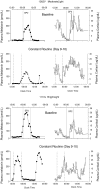
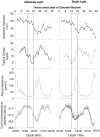
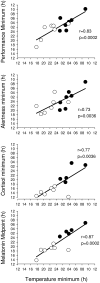
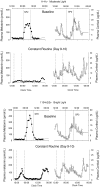
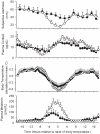
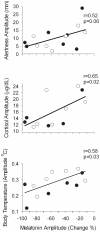
References
-
- Czeisler CA, Dijk D-J. Human circadian physiology and sleep-wake regulation. In: Takahashi JS, Turek FW, Moore RY, editors. Handbook of Behavioral Neurobiology: Circadian Clocks. New York: Kluwer Academic/Plenum Publishing Co; 2001. pp. 531–561.
-
- Czeisler CA, Gooley JJ. Sleep and circadian rhythms in humans. Cold Spring Harb Symp Quant Biol. 2007;72:579–597. - PubMed
-
- Welsh DK, Logothetis DE, Meister M, Reppert SM. Individual neurons dissociated from rat suprachiasmatic nucleus express independently phased circadian firing rhythms. Neuron. 1995;14:697–706. - PubMed
Publication types
MeSH terms
Substances
Grants and funding
LinkOut - more resources
Full Text Sources
Other Literature Sources

